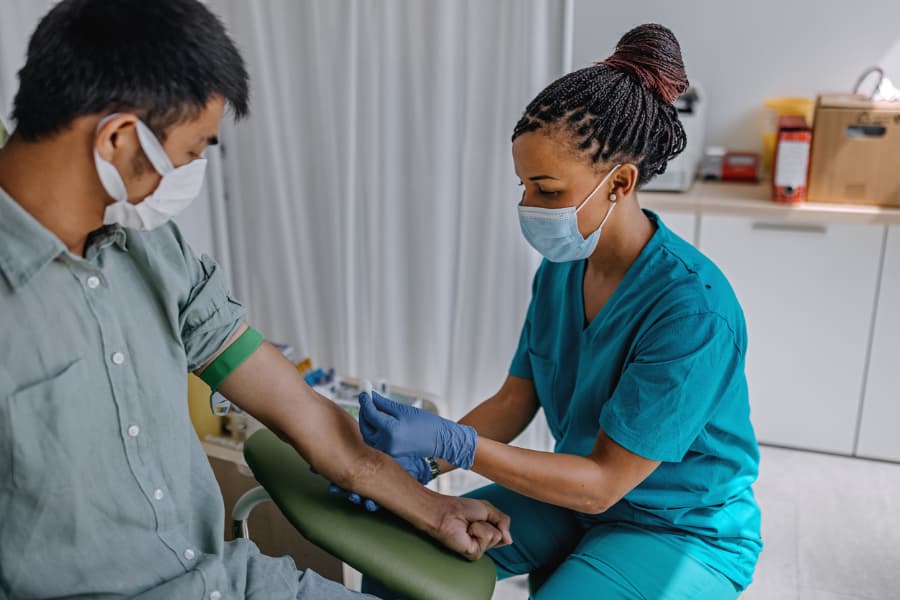Facts About Northeast Medical Institute - New Haven Campus Phlebotomy Course & Cna Class Revealed
Facts About Northeast Medical Institute - New Haven Campus Phlebotomy Course & Cna Class Revealed
Blog Article
Northeast Medical Institute - New Haven Campus Phlebotomy Course & Cna Class Things To Know Before You Get This
Table of ContentsThe Facts About Northeast Medical Institute - New Haven Campus Phlebotomy Course & Cna Class Revealed7 Easy Facts About Northeast Medical Institute - New Haven Campus Phlebotomy Course & Cna Class ExplainedThe Buzz on Northeast Medical Institute - New Haven Campus Phlebotomy Course & Cna ClassThe Main Principles Of Northeast Medical Institute - New Haven Campus Phlebotomy Course & Cna Class The 9-Second Trick For Northeast Medical Institute - New Haven Campus Phlebotomy Course & Cna ClassThe Facts About Northeast Medical Institute - New Haven Campus Phlebotomy Course & Cna Class Revealed
The usage of such tools need to be come with by various other infection avoidance and control techniques, and training in their usage. Not all security gadgets are relevant to phlebotomy. Prior to choosing a safety-engineered device, individuals should completely check out readily available tools to identify their ideal use, compatibility with existing phlebotomy methods, and effectiveness in safeguarding personnel and clients (12, 33).For setups with low sources, cost is a driving consider procurement of safety-engineered tools - CNA Courses. Where safety-engineered devices are not available, knowledgeable usage of a needle and syringe serves. Unintentional direct exposure and details details concerning a case must be recorded in a register. Support solutions must be advertised for those who go through unintentional direct exposure.
In the blood-sampling room for an outpatient division or facility, supply a comfy reclining sofa with an arm remainder.
The Best Guide To Northeast Medical Institute - New Haven Campus Phlebotomy Course & Cna Class
Guarantee that the indications for blood tasting are clearly defined, either in a created procedure or in recorded directions (e.g. in a lab form). In all times, comply with the strategies for infection prevention and control listed in Table 2.2. Infection avoidance and control methods. Accumulate all the equipment required for the procedure and location it within secure and simple reach on a tray or trolley, ensuring that all the things are clearly visible.
Where the client is grown-up and conscious, adhere to the steps detailed listed below. Introduce on your own to the client, and ask the person to state their complete name. Examine that the laboratory type matches the individual's identity (i.e. match the client's information with the research laboratory form, to ensure accurate recognition). Ask whether the patent has allergic reactions, anxieties or has ever before collapsed throughout previous injections or blood draws.
Make the person comfy in a supine placement (when possible). Area a tidy paper or towel under the person's arm. Review the test to be done (see Annex F) and acquire verbal authorization. The person has a right to decline an examination at any moment before the blood sampling, so it is very important to make sure that the person has understood the procedure.
The Single Strategy To Use For Northeast Medical Institute - New Haven Campus Phlebotomy Course & Cna Class
Prolong the patient's arm and examine the antecubital fossa or lower arm. Locate a capillary of an excellent dimension that is visible, straight and clear.
DO NOT place the needle where veins are diverting, since this raises the opportunity of a haematoma. The vein ought to show up without applying the tourniquet. Situating the vein will certainly help in determining the right dimension of needle. Apply the tourniquet regarding 45 finger sizes over the venepuncture website and re-examine the capillary.
Samplings from central lines bring a risk of contamination or incorrect lab test outcomes. It is acceptable, yet not suitable, to attract blood samplings when very first introducing an in-dwelling venous device, prior to connecting the cannula to the intravenous liquids.
The Buzz on Northeast Medical Institute - New Haven Campus Phlebotomy Course & Cna Class
Failing to allow adequate get in touch with time enhances the danger of contamination. DO NOT touch the cleaned up website; in specific, DO NOT position a finger over the blood vessel to lead the shaft of the subjected needle.
Ask the individual to create a fist so the blood vessels are extra prominent. Get in the blood vessel swiftly at a 30 level angle or less, and remain to introduce the needle along the vein at the simplest angle of access - PCT Courses. Once sufficient blood has been collected, launch the tourniquet BEFORE taking out the needle
8 Simple Techniques For Northeast Medical Institute - New Haven Campus Phlebotomy Course & Cna Class
Take out the needle carefully and apply mild pressure to the site with a clean gauze or completely dry cotton-wool ball. Ask the patient to hold the gauze or cotton woollen in location, with the arm extended and elevated. Ask the patient NOT to flex the arm, since doing so creates a haematoma.

The 8-Second Trick For Northeast Medical Institute - New Haven Campus Phlebotomy Course & Cna Class
Do not press the syringe plunger since added pressure enhances the risk of haemolysis. Where possible, keep the tubes in a rack and relocate the shelf in the direction of you. Inject downwards into PCT Courses the ideal coloured stopper. DO NOT eliminate the stopper since it will certainly launch the vacuum cleaner. If the sample tube does not have a rubber stopper, inject very slowly right into the tube as lessening the stress and velocity used to transfer the specimen decreases the threat of haemolysis.

Report this page